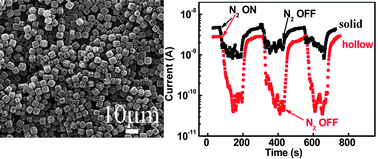We report a facile fabrication of 2,5,8,11-tetra-butyl perylene (TBPe) hollow structures with well defined geometries from microcubes to higher order hierarchical hollow architectures (octa-pod framework) by a template-free method under mild conditions. In this work, primary crystallites formed at the early stage do not follow the conventional route to grow into larger crystals, but rather choose to aggregate directionally to self construct into well-defined geometrical structures. Afterwards, core dissolution takes place in the central part viaOstwald ripening processes, where smaller metastable primary particles (crystallites) undergo mass relocation through dissolution and recrystallization from the centre to the surface, leaving a hollow interior architecture. By manipulating the growth kinetics, shapes of the as-prepared hollow architectures can be easily tuned from cage-like cubes to more complex octa-pod frameworks. The formation process has been investigated through the morphology evolution at different aging times, and possible formation mechanisms are proposed. This is the first example, to the best of our knowledge, of organic crystals following the reversed crystal growth route. Ostwald ripening processes are also verified to play a critical role for the hollowing of the crystals. These hollow structures with rough inner and outer surfaces find excellent humidity sensor applications with a fast response to the humidity change, along with an excellent device stability and reproducibility. The present findings offer guidelines for developing well-defined organic crystals with hollow interior spaces.

